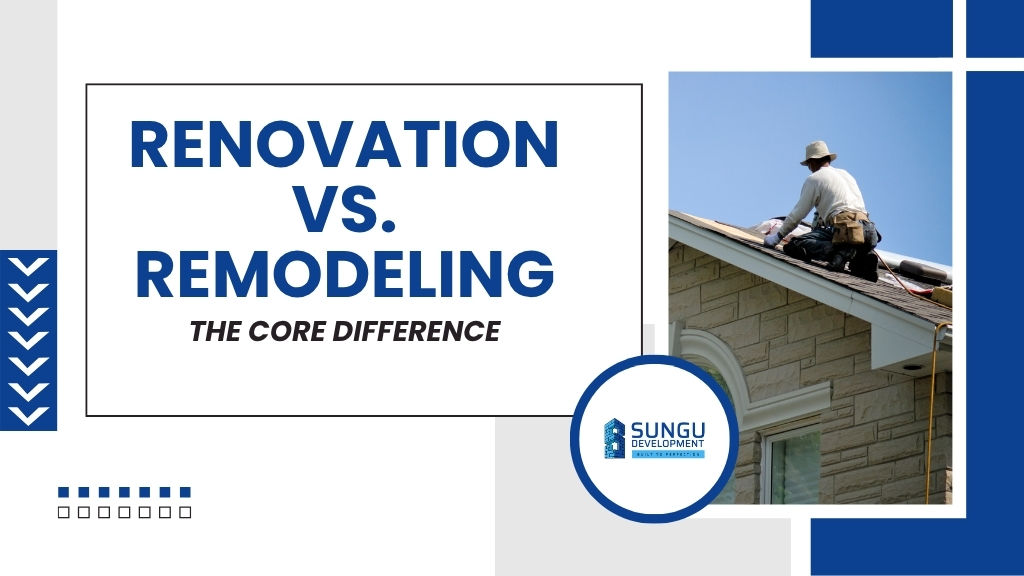
Homeowners and property managers often use renovation and remodeling interchangeably, but they’re not the same. Understanding the difference helps you set the right budget, obtain the correct permits, manage timelines, and protect your return on investment.
Renovation vs. Remodeling: The Core Difference
- Renovation means restoring or updating what already exists without fundamentally changing the layout. Think: repairing drywall, refinishing floors, replacing cabinets in the same configuration, new fixtures, repainting, or upgrading finishes and appliances.
- Remodeling means changing the structure, layout, or use of a space. Think: removing or adding walls, reconfiguring kitchens and baths, moving plumbing or electrical, adding an ensuite, or building an addition.
Quick rule of thumb: If you’re keeping the same floor plan, it’s typically a renovation. If you’re changing the way the space works, it’s a remodel.
Side-by-Side Comparison
| Factor | Renovation | Remodeling |
| Primary Goal | Refresh/repair existing spaces | Reconfigure or add new spaces |
| Scope | Surface updates and like-for-like replacements | Structural changes, layout shifts, MEP* relocations |
| Typical Permits | Sometimes (roofing, windows, exterior, electrical) | Often required (structural, plumbing, electrical, additions) |
| Timeline | Usually shorter, less disruptive | Longer, phased, more trade coordination |
| Cost Profile | Lower; more predictable | Higher; contingencies more critical |
| ROI Potential | Strong for “light” updates | High when layout/function improves significantly |
| Disruption | Moderate; often can remain in place | Higher; temporary relocation may be needed |
MEP = Mechanical, Electrical, Plumbing.
When to Choose Renovation
- Surfaces are tired but functional. Paint, flooring, tile, and fixtures will modernize the space.
- You’re prepping to sell. Cosmetic upgrades can deliver quick wins for curb appeal and buyer perception.
- Budget and time are tight. Renovations can be phased room by room with less disruption.
- Systems are sound. No need to move walls or reroute services.
Examples: Reface cabinets and swap countertops, replace vanity and lighting, refinish hardwoods, upgrade to LED lighting, repaint interior/exterior.
When to Choose Remodeling
- The layout doesn’t work. You need an open kitchen, bigger primary suite, or better traffic flow.
- Code or safety issues exist. Structural repairs, egress improvements, or accessibility upgrades.
- You’re adding square footage. A new bathroom, dormer, ADU, or full addition.
- You’re integrating new functions. Home office suites, multi-gen living, or rental conversions.
Examples: Remove a bearing wall (with proper beam design), add an island by relocating plumbing/electrical, convert a tub to a curbless shower with new drain locations, build a second-story addition.
Permits, Codes, and Inspections
- Renovation: Many cosmetic updates don’t need permits, but exterior changes, window replacements, roofing, electrical circuits, and HVAC equipment often do.
- Remodeling: Nearly always permitted—especially for structural changes, plumbing/electrical relocation, and additions.
- Expect plan review, staged inspections (framing, rough MEP, insulation, finals), and potential HOA/strata approvals where applicable.
Tip: Ask your contractor to confirm the permit matrix up front (what requires permits, inspection sequence, estimated timelines).
Budget, Timeline, and Contingencies
- Budgeting: Renovations generally cost less per square foot; remodels can rise quickly due to structural engineering, rerouting services, and unforeseen conditions inside walls.
- Contingency: Keep 10–20% contingency (closer to 20% for older homes or complex remodels).
- Timeline: Renovations might finish in weeks; remodels commonly take months, especially with custom millwork, long-lead windows, or specialty tile.
Cost drivers: scope creep, structural surprises, lead times, change orders, and specialty finishes.
ROI and Resale Considerations
- Renovation ROI: Fresh paint, updated lighting, resurfaced cabinets, and new hardware often yield strong returns because they improve visual impact at lower cost.
- Remodel ROI: Major kitchen/bath reconfigurations and additions can pay off when they solve functional pain points (storage, flow, accessibility).
- Neighborhood fit matters: Over-improving beyond the area’s typical finish level can reduce ROI.
Insurance, Taxes, and Financing
- Insurance: Notify your insurer before major work; remodeling that opens walls or changes structure can affect risk and coverage.
- Taxes: Additions and substantial remodels can influence assessed value; cosmetic renovations usually have less impact—check local rules.
- Financing: Consider renovation loans, HELOCs, cash-out refis, or contractor financing for larger scopes.
Choosing the Right Partner
- General contractor (GC) or design-build firm for turnkey delivery and single-point accountability.
- Architect/engineer when moving walls, changing rooflines, or adding square footage.
- Specialty trades (licensed electricians, plumbers, HVAC) for code-critical systems.
- Request references, view recent projects, and insist on a detailed scope, schedule, and allowance list.
Practical Planning Checklist
- Define the goal: cosmetic refresh vs. functional re-layout.
- Set a realistic budget (with contingency) and prioritize must-haves vs. nice-to-haves.
- Lock selections early (tile, windows, appliances) to avoid delays.
- Confirm permits and inspection milestones before demolition.
- Schedule site meetings and approve change orders in writing.
- Plan for living arrangements if the kitchen/bath will be offline for weeks.
- Close out properly: punch list, warranties, final lien releases, and as-built notes/photos.
Conclusion
Renovation refreshes what you have; remodeling changes how your space works. Your best choice depends on goals, budget, disruption tolerance, and code requirements. Define your scope clearly, line up the right professionals, plan for permits, and keep a solid contingency. Do that, and you’ll get the look—and function—you really want, without unpleasant surprises.
FAQs
Is remodeling more expensive than renovating?
Typically yes. Remodeling involves structural work, service relocations, and more inspections—raising complexity and cost.
Do I need a permit to renovate?
Many cosmetic tasks don’t require permits, but exterior changes, window swaps, roofing, new circuits, and HVAC replacements often do. Always verify locally.
Which delivers better resale value—renovation or remodel?
Light, well-executed renovations often deliver strong ROI. Remodels can match or exceed that when they solve layout problems buyers care about.
